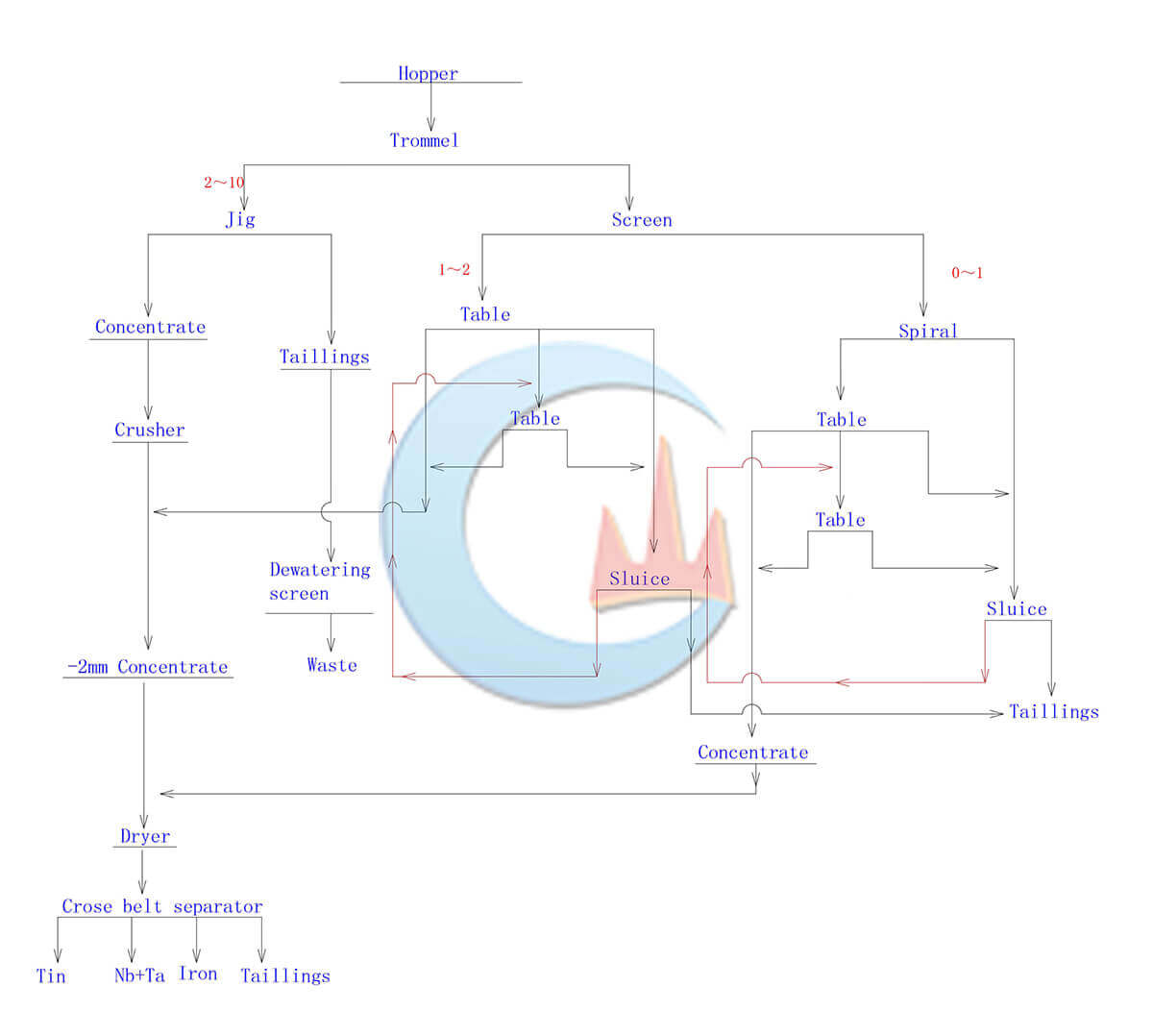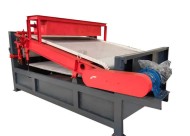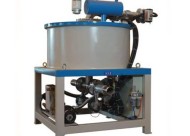The tantalum-niobite is mostly tantalum, niobium-tin, tungsten, lithium, beryllium, and other polymetallic ores. It has the characteristics of low raw ore grade, complex mineral composition, high mineral density, and brittleness. The beneficiation methods mainly adopt gravity separation, magnetic separation, electric separation, flotation, and chemical treatment. The beneficiation process is generally divided into two parts: roughing and concentration.
Tantalite-niobite Roughing
The primary beneficiation process of Tantalite-niobite roughing is the gravity separation process. It uses the process as gravity separation-flotation-gravity separation, gravity separation-flotation( or gravity separation)-magnetic separation-gravity separation.
Gravity Process
The primary tantalum and niobium ore mainly adopt stage grinding and multi-stage gravity separation. Separation equipment is usually added to the grinding circuit to recover individual minerals in advance. Due to the better dissociation of the mineral monomer, the tantalum-niobium placer generally does not need crushing and grinding. It’s screening before selection to remove boulders and pebbles, then rough selection. Coarse-grained tantalite-niobite is roughened by jig or spiral concentrator (including rotating spiral chute), rougher concentrate is selected by shaking table; fine-grained tantalite-niobite is selected by spiral chute or shaker. The tantalum and niobium slime are roughened by a centrifugal concentrator or multi-layer turning bed. The roughing concentrate is selected by belt chute or grooved belt chute combined with mud shaking table. The characteristics of this process are less investment, low cost, and less environmental pollution. But the efficiency of sludge separation is low.
Gravity Separation – Flotation – Gravity Separation or Gravity Separation – Flotation
Gravity separation is used for coarse and fine-grained materials, and flotation is used for sludge. Before flotation, a small-diameter cyclone or a centrifugal concentrator is generally used for desliming, and then alkyl sulfosuccinate is used as a collector, sodium silicate, and oxalic acid are used as regulators, and the flotation is carried out under the condition of pH 2-3. The flotation concentrate is selected with Holman mud shaker-cross-flow belt chute; or styrene phosphonic acid is used as collector, sodium fluorosilicate and lead nitrate are used as regulators, and flotation is carried out under the condition of pH6, the flotation concentrate is selected with a vibrating belt chute or a cross-flow belt chute, and hydroxamic acid and transformer oil (2:1) can also be used as collectors, and sodium hydroxide and sodium silicate are used as regulators. The flotation is carried out under the conditions of 8.5, and the flotation concentrate is added with hydroxamic acid and transformer oil, and oxalic acid is used as an inhibitor, and the selection is carried out under the condition of pH 2.5-3. According to the above methods, tantalite or niobite concentrate can be obtained. The characteristics of this process are that the selection index is high, but the content of tantalum and niobium in the removed fine mud is mainly close to the grade of the original ore, the consumption of chemicals is large, and the production cost is high.
Gravity Separation – Magnetic Separation – Gravity Separation
The coarse-grained materials use gravity separation. The fine-grained fraction and the ore slime are combined with magnetic and gravity separation. This process is characterized by high sorting efficiency for fine-grained tantalite and niobium ore, but all tantalum and niobium minerals in the ore must have weak magnetic properties.
Tantalite – Niobite Concentration
Tantalite-niobite rough concentrates are generally complex in composition and difficult to separate, often requiring the use of one to two or a combination of methods such as magnetic separation, gravity separation, flotation separation, electrical separation, and chemical treatment. In particular, the separation of tantalite, niobite, and some refractory minerals require a combination of various sorting methods. For example, tantalite-niobite is separated from garnet and tourmaline, usually by magnetic separation, electric separation, or flotation.
Magnetic Separation
Their specific magnetic susceptibility: 2.4 × 10-5 cm3/g for tantalite, 2.5 × 10-5 cm3/g for niobite, 5.8 × 10-5 cm3/g for yttrium niobite, 5.8 × 10-5 cm3/g for pomegranate Stone and tourmaline change with their iron content. When the Fe2O3 range of garnet increases from 7% to 25%, its specific magnetic susceptibility increases from 11×10-6 cm3/g to 124×10-6 cm3 /g (11 times growth), when the Fe2O3 content of tourmaline increases from 0.3% to 13.8%, its specific magnetic susceptibility increases from 1.1×10-6 cm3/g to 30×10-6 cm3/g (increase 30 times). In order to improve the selectivity of mineral separation in the magnetic field, acid (solid: liquid = 1:5) is generally used for short-term (5-15 minutes) treatment to remove iron on the surface of minerals and then separate in magnetic fields of different intensities From garnet and tourmaline, tantalum and niobium concentrate can be obtained.
Electric Separation
The materials are screened and classified at a narrow level, then heated separately, and electrically selected in a composite electric field: generally, low voltage (20-35 kV), considerable pole distance (80-100 mm), slow Rotational speed (low centrifugal force) (roller or drum revolutions 33-38 rpm). -0.2~+0.08mm particle size generally uses high voltage (35-45kV), small pole distance (50-80mm), and high speed (high centrifugal force) (roller speed is 70-118 rpm). Tantalite-niobite can be separated from garnet.
Flotation Separation
Niobite and Garnet Separation
Collector uses sodium cetyl sulfonate, and regulators use fluorine compound to separate niobate and garnet.
Separation of tantalum-niobite from monazite
Coarse-grained grades usually use electric separation. For fine-grained grades (-0.075 mm), collectors use oleic acid or rice bran oil, regulators use sodium carbonate (Na2CO3), and inhibitors agent (Na2SiO3:Na2S=3:1) use sodium silicate (Na2SiO3) and sodium sulfide (Na2S). The emergence of monazite at pH 9 allows the separation of iron-tantalite (niobite) from monazite.
Separation of fine spar and cassiterite
The coarse grade is usually electrostatically selected (voltage 16 kV). Treat the fine grades with 2% hydrochloric acid for 15 minutes. Then the collector uses 600 g/ton of sodium alkyl sulfate, and the inhibitor uses sodium fluorosilicate (Na2SiF6). Cassiterite emerges under the condition of pH 2-2.3, which can separate fine spar from cassiterite.
Separation of tantalum-niobite and magnetic cassiterite
A wind shaker generally separates the coarse-grained grade. For the fine-grained grade, a new magnetic separation process of oxidative roasting (800-900℃) can separate tantalum niobite, tantalum rutile, and cassiterite well.
Separation of tantalum-niobite and wolframite
It usually uses hydrometallurgy. First, grind the material to -0.04 mm, add sodium carbonate (Na2CO3) for roasting (800 ℃), or cook with concentrated alkali under normal pressure. After filtering, the filter residue is decomposed with HCl (5%) to obtain artificial tantalum-niobium concentrate. The filtrate is a sodium tungstate solution. After acid adjustment (pH2-2.5), extraction, neutralization, crystallization, and other procedures, it can obtain tungsten oxide (WO3).
Separation of niobite and zircon
It can use magnetic separation or flotation. In flotation, the collector uses sodium oleate, and the regulators use lead chloride, water glass, lead chloride, and oxalic acid. They can separate niobate from zircon.
LATEST PRODUCTS
-
Heavy Plate Feeder
Capacity: 100-240 m3/h Power: 15-45 kW Speed: 0…
-
Plate Magnetic Separator
【Capacity】8-35 t/h 【Power】1.5-3 kW 【Applic…
-
Slurry Magnetic Separator
【Capacity】10-100 m3/h 【Feeding Material Densi…










